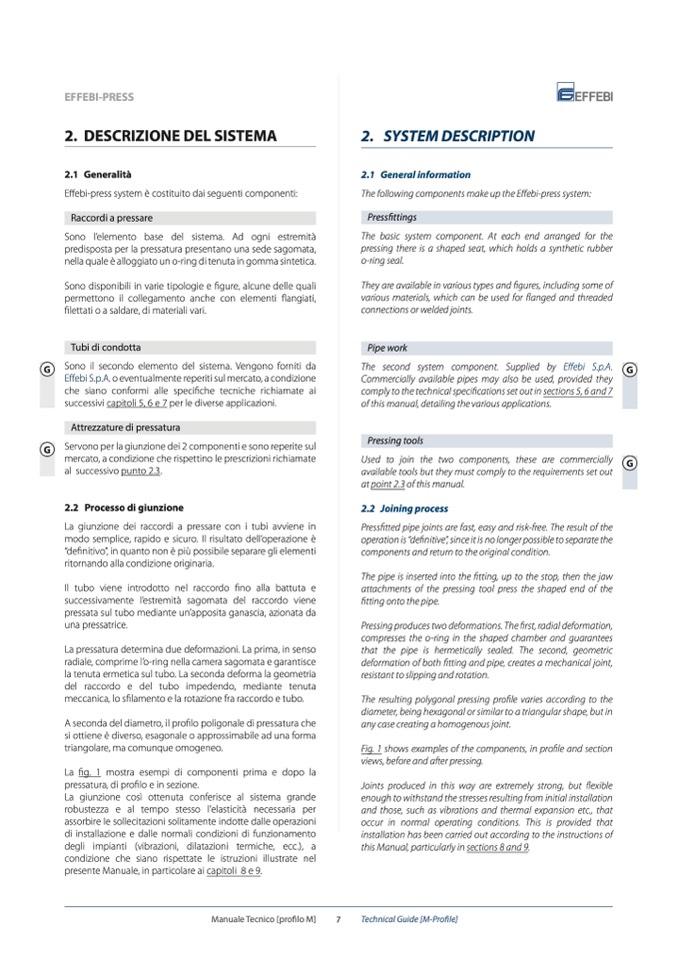
G
G
G
EFFEBI-PRESS
2. DESCRIZIONE DEL SISTEMA
2.1 Generalità
Effebi-press system è costituito dai seguenti componenti:
Raccordi a pressare
Sono l’elemento base del sistema. Ad ogni estremità
predisposta per la pressatura presentano una sede sagomata,
nella quale è alloggiato un o-ring di tenuta in gomma sintetica.
Sono disponibili in varie tipologie e
figure, alcune delle quali
permettono il collegamento anche con elementi flangiati,
filettati o a saldare, di materiali vari.
Tubi di condotta
Sono il secondo elemento del sistema. Vengono forniti da
Effebi S.p.A. o eventualmente reperiti sul mercato, a condizione
che siano conformi alle specifiche tecniche richiamate ai
successivi capitoli 5, 6 e 7 per le diverse applicazioni.
Attrezzature di pressatura
Servono per la giunzione dei 2 componenti e sono reperite sul
mercato, a condizione che rispettino le prescrizioni richiamate
al successivo punto 2.3.
2.2 Processo di giunzione
La giunzione dei raccordi a pressare con i tubi avviene in
modo semplice, rapido e sicuro. Il risultato dell’operazione è
“definitivo”, in quanto non è più possibile separare gli elementi
ritornando alla condizione originaria.
Il tubo viene introdotto nel raccordo fino alla battuta e
successivamente l’estremità sagomata del raccordo viene
pressata sul tubo mediante un’apposita ganascia, azionata da
una pressatrice.
La pressatura determina due deformazioni. La prima, in senso
radiale, comprime l’o-ring nella camera sagomata e garantisce
la tenuta ermetica sul tubo. La seconda deforma la geometria
del raccordo e del tubo impedendo, mediante tenuta
meccanica, lo sfilamento e la rotazione fra raccordo e tubo.
A seconda del diametro, il profilo poligonale di pressatura che
si ottiene è diverso, esagonale o approssimabile ad una forma
triangolare, ma comunque omogeneo.
La fig. 1 mostra esempi di componenti prima e dopo la
pressatura, di profilo e in sezione.
La giunzione così ottenuta conferisce al sistema grande
robustezza e al tempo stesso l’elasticità necessaria per
assorbire le sollecitazioni solitamente indotte dalle operazioni
di installazione e dalle normali condizioni di funzionamento
degli impianti (vibrazioni, dilatazioni termiche, ecc.), a
condizione che siano rispettate le istruzioni illustrate nel
presente Manuale, in particolare ai capitoli 8 e 9.
2. SYSTEM DESCRIPTION
2.1 General information
The following components make up the Effebi-press system:
Pressfittings
The basic system component. At each end arranged for the
pressing there is a shaped seat, which holds a synthetic rubber
o-ring seal.
They are available in various types and figures, including some of
various materials, which can be used for flanged and threaded
connections or welded joints.
Pipe work
The second system component. Supplied by Effebi S.p.A.
Commercially available pipes may also be used, provided they
comply to the technical specifications set out in sections 5, 6 and 7
of this manual, detailing the various applications.
Pressing tools
Used to join the two components, these are commercially
available tools but they must comply to the requirements set out
at point 2.3 of this manual.
2.2 Joining process
Pressfitted pipe joints are fast, easy and risk-free. The result of the
operation is “definitive”, since it is no longer possible to separate the
components and return to the original condition.
The pipe is inserted into the fitting, up to the stop, then the jaw
attachments of the pressing tool press the shaped end of the
fitting onto the pipe.
Pressing produces two deformations. The first, radial deformation,
compresses the o-ring in the shaped chamber and guarantees
that the pipe is hermetically sealed. The second, geometric
deformation of both fitting and pipe, creates a mechanical joint,
resistant to slipping and rotation.
The resulting polygonal pressing profile varies according to the
diameter, being hexagonal or similar to a triangular shape, but in
any case creating a homogenous joint.
Fig. 1 shows examples of the components, in profile and section
views, before and after pressing.
Joints produced in this way are extremely strong, but flexible
enough to withstand the stresses resulting from initial installation
and those, such as vibrations and thermal expansion etc., that
occur in normal operating conditions. This is provided that
installation has been carried out according to the instructions of
this Manual, particularly in sections 8 and 9.
G
Manuale Tecnico [profilo M]
7
Technical Guide [M-Profile]

